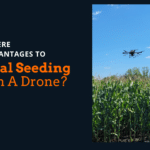We’re excited to offer our custom drone seeding service to farmers throughout the Upper Midwest. Crop Fertility Services is located in Cokato, Minnesota. Brian Halonen, long-time CFS employee and owner of Elevated Ag Solutions, can be contacted by call or text at (320)266-8072 for a any drone related questions you may have.
Brian uses a DJI T-30 drone built specifically for agricultural use to effectively seed cover crops with a drone. If you plan on joining us for the Organic Farm Innovation Expo that we host annually, you’re in for a treat as Elevated Ag Solutions will be demonstrating it’s drone capabilities at the event.
Major Advantages Of Using A Drone To Seed Cover Crops
Cover crops are used in a wide variety of situations across farming operations all over the world. Cover crops are an effective tool to get a Nitrogen credit into the soil and in many cases, there are cover crop programs that will help to cover or partially cover the cost of using them on your ground. On top of their use in cash crop operations, cover crops as livestock forage can add major value to your ground.
While they’re viable, many farmers shy from cover crops. There are many ways to make cover crops work on an organic farm and the use of a drone can help tremendously.
On the contrary, there can be risks to drone seeding cover crops. While we believe that the advantages to drone seeding cover crops far outweigh the risks, large rain events can play a factor into whether or not you decide to seed a certain day.
Field Conditions Do Not Affect Drone Seeding
One of the major benefits to using a drone for seeding cover crops is that field conditions do not affect planting ability. This means that not only can you get out to seed cover crops at any time, there is the added benefit of timing. Like any crop, seeding at the ideal time can have a major impact on growth performance.
When seeding cover crops with a drone, application just prior to or immediately following a rain event makes a big difference in the cover crops success. Our ability to plant in nearly any condition (high winds are a no go) gives a cover crop seeding the best chance at getting a great start.
Drones Can Plant Into Standing Crops
One of the main reasons farmers never consider cover crops in their rotation is because the standing crop prohibits the planting of them. With a drone, a cover crop can be seeded into any standing crop, regardless of it’s current height.
For organic farmers considering cover crops in their rotation, this is a tremendous advantage because it allows them to maximize early season weed control through tine weeding and cultivating, planting a cover crop after all of their mechanical weed control is completed or prohibited by the size of the growing crop.
In the fall of 2022, we successfully seeded cover crops into a standing corn crop for use in post harvest grazing with cattle. The farmer was able to take advantage of a cover crop incentive program available in his county, which added feed value to the land he had planned on grazing regardless. Of course, the cattle grazing the harvested corn added additional fertility to the ground through their manure.
In this case, we had seeded the cover crop very late in the growing season, but were still able to achieve excellent cover crop growth. The photo below shows an example of the typical growth we saw on these acres.
Zero Soil Compaction
It goes without saying, drones aren’t a heavy piece of equipment that further compacts the soil. This is a huge benefit to seeding cover crops, particularly to organic farmers who spend more time than conventional farmers tine weeding, cultivating, and other mechanical weed control measures throughout the growing season.
Never mind the fact that seeding cover crops into a standing crop is a near impossible task (depending on the stage of the crop being grown), drones do not compact the soil at all. Each time a tractor crosses the ground, crop yield is reduced due to soil compaction and drones take this risk away completely.
Get Maximum Coverage When Broadcast Spreading
With any planter, cover crops are seeded in row, which has a slight disadvantage when compared to broadcast spreading. While it’s not the biggest benefit to seeding with a drone, there is an advantage to broadcast spreading. This allows the cover crop to grow tight to a standing row crop, fixing nutrients in the widest coverage area possible for the next crop to benefit from.
Take Advantage Of Cover Crop Incentive Programs
In the state of Minnesota, there are cover crop incentive programs in nearly every county. These programs are designed specifically to encourage more farming operations to take advantage of cover crops in their rotation, which provides benefit to both the farmer and the land surrounding their operation.
If a cover crop incentive program can cover the cost of seeding, farmers should strongly consider adding them to their rotation. Brian Halonen is an expert on cover crop incentive programs and calling to find out what’s available in your area is a worthy use of your time. He can be reached by call or text at (320)266-8072 for any questions you have.
Pasture And Food Plot Seeding
On top of the obvious benefits for row crop farmers, drones provide a versatile way for farmers and outdoors folks to seed pasture and food plots, whether it’s frost seeding with a drone or simply using a drone to plant food plots for deer and other wildlife in hard to reach areas. This spring, we’ve been able to successfully seed alfalfa into fields using our drone while frost was still in the ground.














